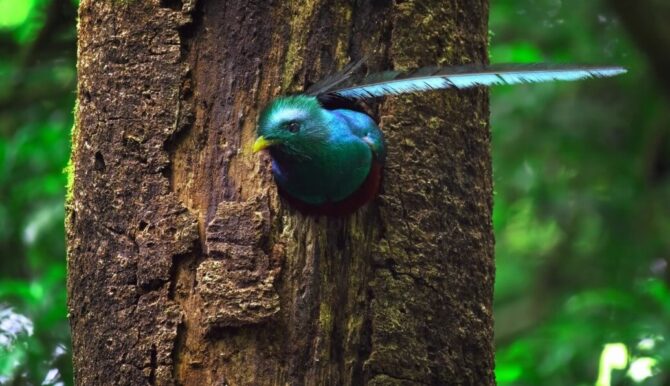People who love animals often choose pet birds as their feathered friends.
While some birds can sing lovely songs, others can mimic human speech for entertaining conversations.
Talking birds are unique and fascinating, with only a few species capable of speaking due to their exceptional brain structure and intelligence.
In this article, we’ll look at the most common pet birds that can talk and provide photos to help you recognize them.
We’ll also answer intriguing questions like “How do birds talk without vocal cords?”
Keep reading to learn more.
15 Species of Pet Birds That Can Talk
Birds that can talk have a remarkable talent for mimicking human speech, making them a unique type of pet.
Besides their mimicry skills, their charming personalities and engaging nature also set them apart and have made them popular for generations.
The African gray parrot is known for having vast vocabularies, while other talking birds have smaller ones.
Here’s a list of the most popular talking bird species for you to learn about their unique qualities.
1. African Gray Parrot
Scientific Name: Psittacus erithacus
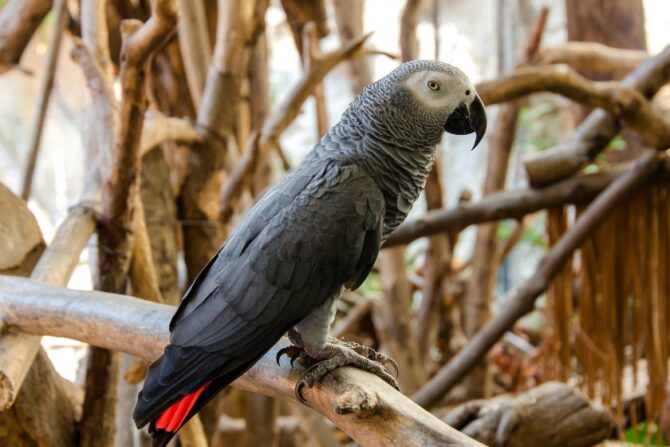
African gray parrots are widely considered to be among the most intelligent pet birds due to their exceptional speaking ability.
These birds can learn and mimic up to 1,000 words with accurate pronunciation.
Not only can they imitate human speech, but they can also understand and respond to complex commands.
Unlike most other talking birds, studies have shown that African gray Parrots can use words in context.
A 26-month training program resulted in a parrot that could identify, request, or refuse objects by combining nine nouns, three adjectives, two phrases for describing shape, and the word “no.”1
While gray parrots make great pets for those willing to put in the time and effort to train them, they are not suitable for beginners and require a lot of patience and dedication.
They are also considered a costly investment.
2. Amazon Parrot
Scientific Name: Amazona
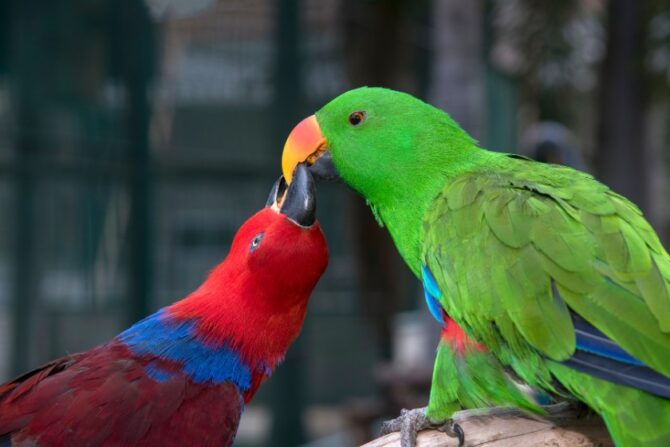
Amazon parrots are another well-liked pet bird species famous for their excellent speaking skills, particularly the yellow-naped variety.
This variety can speak more clearly and string together multiple words in phrases better than African grays.
Amazon parrots are highly social and interactive birds that enjoy talking to their owners and mimicking sounds they hear.
These parrots are popular for their mimicking ability, and they make really great pets for those who enjoy a more active bird.
They are playful, curious, and intelligent, which makes them an ideal companion for families.
Amazon parrots are also highly adept at learning tricks and even singing.
However, many owners claim that they become highly attached to their keepers and may act aggressively toward strangers.
3. Budgerigar
Scientific Name: Melopsittacus undulatus
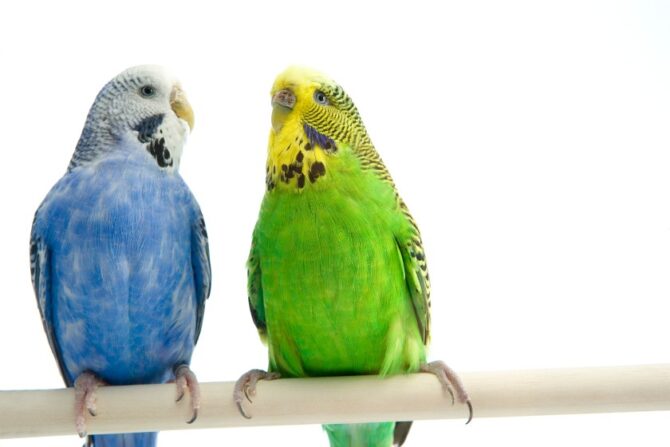
Budgerigars, also known as budgies or parakeets, are well-liked pet bird species known for their lively and outgoing personalities.
In addition to their social nature, they can also learn to talk and mimic many words and sounds.
Like other talking birds, budgies do not have vocal cords and instead produce sounds by manipulating the muscles in their throat.
This small bird is a popular choice for first-time pet bird owners.
They are easy to care for and are prized for their cheerful personalities.
While budgies may not be as good at mimicking human speech as some of the other birds on this list, they still make delightful pets.
Despite their small size, budgies have a large vocabulary.
In fact, a budgie named Puck holds the Guinness World Record for the largest vocabulary for a bird ever.
It was estimated to know an impressive 1,728 words before its death in 1994.2
4. Blue-Fronted Amazon
Scientific Name: Amazona aestiva
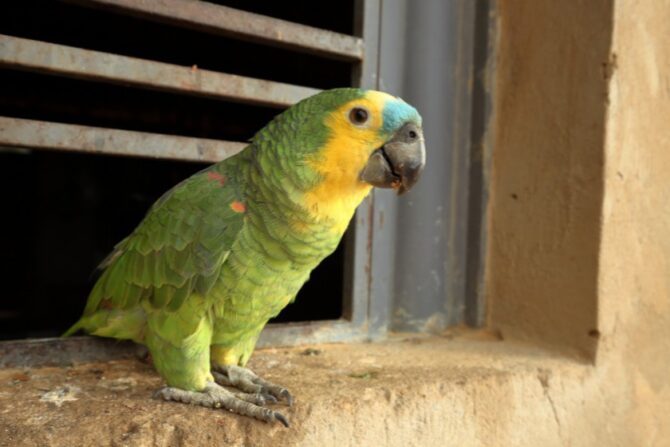
Blue-fronted amazons, also known as turquoise-fronted or blue-fronted parrots, are lively, humorous, friendly, and natural entertainers.
They are excellent talkers and are counted among the best pet birds for this reason.
Blue-fronted amazons can live from 30 to 80 years and are characterized by their bright green feathers, blue forehead, and ability to imitate human speech.
These social birds make great pets with proper training and care, but they require much attention.
They also need both mental and physical stimulation, including interaction with their owners, plenty of toys and activities, and a nutritious diet.
Before getting a blue-fronted amazon, it’s important to understand the responsibilities of pet ownership and do thorough research.
5. Cockatiel
Scientific Name: Nymphicus hollandicus
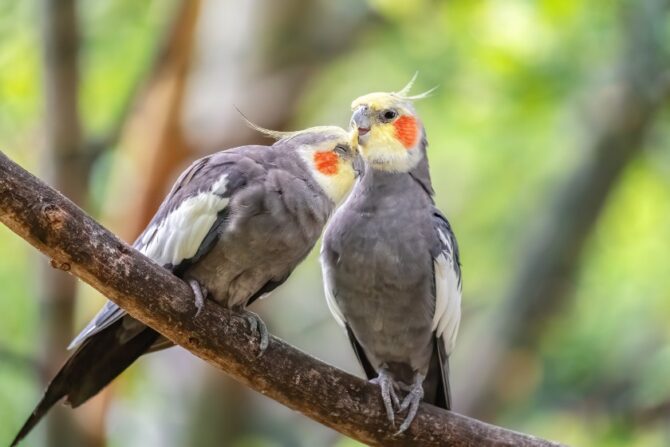
Despite their small size, cockatiels are recognized for their ability to imitate various sounds and words.
While they may not learn as many words as larger parrots, they are intelligent and can speak well enough.
Cockatiels usually start by repeating sounds, but with proper training, they can learn to say simple phrases.
They are also easy to care for, making them a great pet bird choice for first-time bird owners.
Cockatiels are another popular pet bird and are known for their sweet and affectionate personalities.
They are also suitable for kids because of their friendly and social personalities.
It’s important to remember that their lifespan is shorter than larger parrot species, typically 10 to 15 years.
6. Cockatoo
Scientific Name: Cacatuidae

Cockatoos are highly intelligent and social birds that are not known for their talking skills, although they can learn to speak.
These birds have the potential to learn a large vocabulary with proper training.
However, not all cockatoos will talk, though some may learn to imitate many words and sounds.
Cockatoos are also one of the loudest parrot species, despite not having a large vocabulary.
These birds are visually stunning, but their stubbornness can make training difficult.
To encourage a cockatoo to talk, one must be persistent and patient and use positive reinforcement.
7. Yellow-Naped Amazon
Scientific Name: Amazona auropalliata
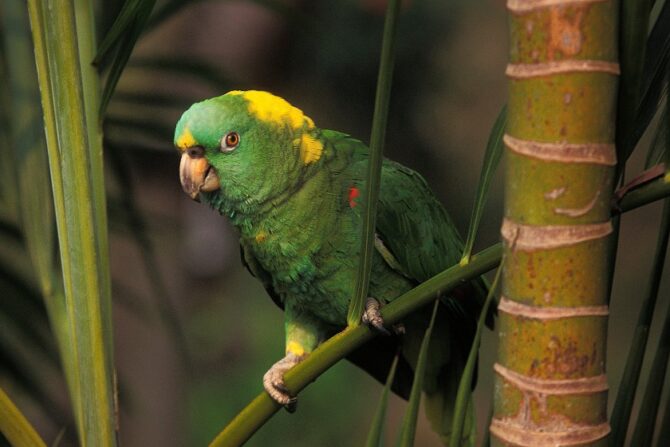
Yellow-naped amazons, also known as yellow-naped parrots, are known for their intelligence, energy, happiness, and exceptional speaking abilities.
They are a parrot species native to Central America and the Pacific slope of southern Mexico.
These birds are known for their distinctive yellow head and neck and their ability to mimic human speech.
Yellow-naped amazons are intelligent and social, making them popular pets.
However, they require a lot of attention and care, as well as a spacious cage, proper diet, and regular socialization.
They are also protected by international wildlife trade laws, so it is important to obtain them from reputable breeders.
8. Eclectus Parrot
Scientific Name: Eclectus roratus
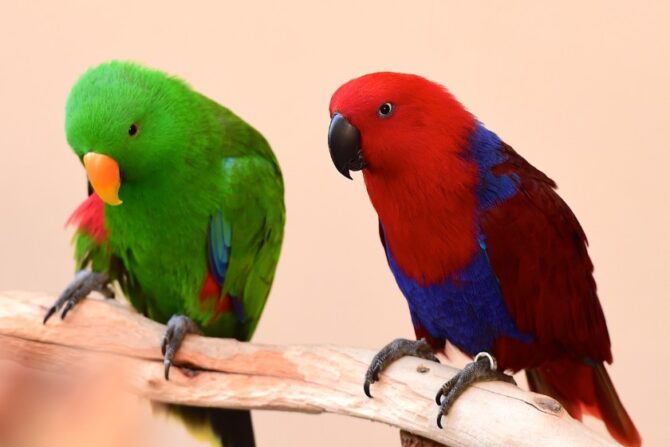
Eclectus parrots, native to New Guinea, are known for their clear speech and singing ability.
They can even sing an entire song.
While males are typically more docile, both sexes possess a natural talent for imitating speech and sounds.
Eclectus parrots are not as loud as other talking birds but are still renowned for their speaking abilities.
They can learn a wide range of human words and become talkative once their vocabulary is extensive enough.
These highly intelligent birds respond well to training.
Training them to speak also provides mental stimulation, reducing the risk of self-destructive behaviors such as feather plucking and mutilation.
9. Hill Myna
Scientific Name: Gracula religiosa
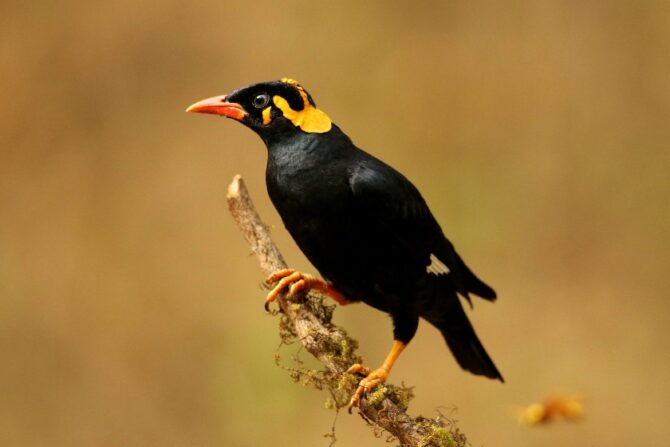
Mynas are small birds that look like crows.
They are well-suited for life in a cage and have social personalities that make them a good choice for beginner pet owners who want a talking bird.
However, not all mynas have an interest in speech.
Nonetheless, early training and consistent positive reinforcement will increase the likelihood of a myna learning to talk.
The hill myna is not a parrot, although it has a large vocabulary comparable to many parrot species.
These birds have a diverse range of vocalizations, including whistling, screeching, and speech that is nearly human-like in tone and timbre.
They are also known to talk a lot.
Hill mynas are lively birds that are friendly when socialized from a young age, and their popularity as pets is increasing.
However, they may not be readily available at a typical pet store and may need to be purchased from a breeder or dealer.
10. Ring-Necked Parakeet
Scientific Name: Psittacula krameri

The ring-necked parakeet, also known as the rose-ringed or Indian ring-necked, is a bird from India and Asia that was once kept by royalty due to its renowned speaking skills.
They are intelligent and known for having large vocabularies.
However, they are more docile and quieter compared to other talking parrots that require a lot of training and interaction with their owners.
These parakeets can learn words and phrases and even enjoy whistling.
They require long-term care and commitment, as they have a lifespan of around 34 years.
11. Macaw
Scientific Name: Ara macao

Macaws are striking pet birds native to Central America, South America, Mexico, and the Caribbean with a talent for mimicking human speech.
They can repeat words, phrases, and even songs and some have a vocabulary large enough to carry on conversations.
Unfortunately, training macaws can prove difficult, as they are intelligent and loud.
Macaws can mimic a wide range of sounds and sing, making them a sought-after pet despite their challenging nature.
However, their speech may not be as clear as other talking parrot species.
Macaws may not be as friendly with strangers as cockatoos, but they are still a popular exotic pet option.
12. Quaker Parrot
Scientific Name: Myiopsitta monachus

Quakers, commonly called monk parakeets, are celebrated for their talking skills and affectionate personalities.
These small, smart, and energetic birds can imitate various sounds through learning, including human speech.
Monk parakeets are highly social creatures and enjoy interaction.
They are also quick learners and can easily pick up words and phrases with minimal training and encouragement.
Although these birds make friendly pets, owning them is illegal in certain states due to their invasive nature and potential harm to agriculture.3
13. Derbyan Parakeet
Scientific Name: Psittacula derbiana

The Derbyan parakeet is a scarce and large parakeet species, roughly about twice the size of a ring-necked parakeet and around the same size as an Alexandrine parakeet.
They have average talking ability.
Adult Derbyan parakeets can be distinguished by the color of their beaks, with males having a reddish-orange beak and females having a black beak.
These birds are lively and energetic but can be difficult to train.
Although they are mostly noisy, they can learn up to several dozen words with training.
Derbyan parakeets are known for their clear speech, even if they don’t have a large vocabulary compared to other parrot species.
Unfortunately, these exotic birds are becoming rarer in the wild due to illegal breeding.
14. Conure
Scientific Name: Pyrrhura molinae
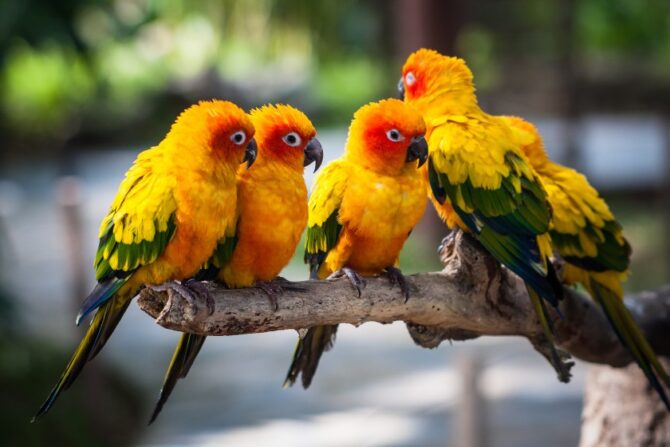
Conures, ranging from small to medium in size, are known for their playful and curious nature, making them endearing to many people.
They enjoy being part of household activities, such as mealtime and spending time with their favorite humans.
These energetic and sometimes comical parrots are a popular choice as pet companions.
Conures are affectionate, cuddly, and at times noisy. They also tend to be bold and inquisitive rather than shy and reserved.
To remain entertained, they need plenty of toys and mentally stimulating activities.
Though their vocabulary may not be as extensive as other parrot species, conures can still learn to say a few words and phrases.
15. European Starling
Scientific Name: Sturnus vulgaris

European starlings are lively and social birds native to Europe and Asia that have been introduced globally.
They enjoy being with their owners and are recognized for their vocal and smart behavior, often mimicking sounds from their surroundings, including human speech.
They can even talk better than parrots.
Starlings are characterized by their shiny, iridescent feathers and can gather in large flocks, creating a stunning display of both sight and sound.
Although they have been kept as pet birds for a long time, most people nowadays avoid keeping them as pets due to their aggressive behavior, untidy habits, and tendency to cause harm to homes and gardens.
Before acquiring a starling as a pet, it’s essential to research its needs and determine if you’re prepared for the challenges of owning one.
Frequently Asked Questions
Will All Talking Birds Talk?
The answer is NO. Not all talking birds will talk.
It’s important to remember that every animal is unique, so not all members of a particular species or breed will have the same characteristics.
It’s possible to get a talking bird that doesn’t talk.
Some birds may require consistent and patient training to talk, while others may never talk on their own.
To encourage your talking bird to talk, it’s important to form a strong bond with it.
Interact with them frequently and use positive reinforcement training.
Even if your pet bird does not talk, you can still enjoy its company and enjoy its other features.
How Do Birds Talk Without Vocal Cords?
Birds are fascinating because they can mimic human speech despite not having lips, teeth, or vocal cords.
This is because they have a syrinx, a muscle and fluid-filled cavity in their chest that functions as a vocal organ.
The syrinx has separate valves that can be altered in depth and shape to produce different sounds.
Do Birds Understand Humans?
Although birds can imitate human speech well, they are highly unlikely to understand the meaning of what they are saying.
They may develop a limited contextual understanding through repeated interactions with their owners.
However, this is based on learned behavior rather than actual understanding of the words.
Conclusion
To sum it all up, pet birds that can talk make great companions for bird owners who want interaction and entertainment.
There’s a perfect pet bird for everyone, whether you’re interested in an intelligent African gray parrot, amazon parrot, cockatiel, quaker parrot, or another species known for its unique personality and talking abilities.
With proper care and training, these birds can bring you joy and friendship for many years.
References & Notes
- Functional Vocalizations by an African Grey Parrot (Psittacus erithacus). ResearchGate
- Largest vocabulary for a bird ever. Guinness World Records
- Risk assessment for Myiopsitta monachus (Monk parakeet). Recercat



